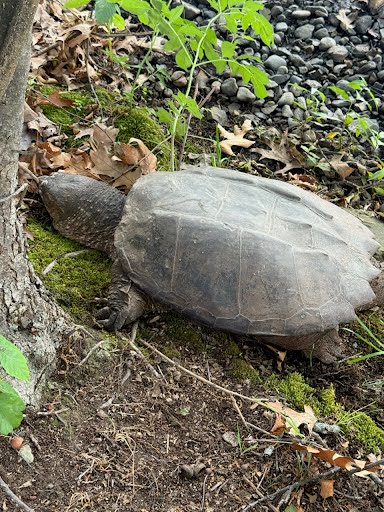
A large snapping turtle was found dead near the bank of Charles River in Watertown, and the cause of death was determined to be from a rodent poison that prevents blood from clotting. The case is the first documented death of a snapping turtle by rodenticide in Massachusetts, according to a wildlife advocacy group.
The turtle was found in July and the veterinarian who determined the cause of death, Amanda Leef from Heal Veterinary Clinic in East Watertown, said it is unusual to see a turtle die in that way.
Leef has a wildlife rehabilitation license, and does work with Save Mass Wildlife to study sick and dead wildlife. anticoagulant rodenticide poisoning. She said it is not uncommon to see animals such as hawks and coyotes die from ingesting anticoagulant rodenticide poisoning. She has also seen gray foxes and skunks, but recently she has seen some more unusual cases.
“Probably the two most interesting ones I’ve tested were a Great Blue Heron that tested positive — and those are not animals that normally eat rats and mice on a regular basis. We thought that the Great Blue Heron had died because it was tangled in fishing line, which is a whole other problem, but it actually tested positive for rodenticide poisoning,” Leef said. “And then the turtle. It was a really large, I think a 30 pound snapping turtle. It was found in Watertown.”
Save Mass Wildlife said snapping turtles are known as “ecosystem engineers” because they clean up ponds, lakes, and rivers by consuming dead animals that they find in and near their water habitats. The group released a statement about the discovery of the dead turtle.
“The confirmation of the first turtle mortality due to poisoning from second generation anticoagulant rodenticides (SGARs) in the state offers more proof of how pervasively these rat poisons are infiltrating the food chain, even in animals not typically considered vulnerable to these toxins,” the statement said. “Turtles already face a multitude of threats, from vehicle collisions to fishing line entanglements and ingestion. Now rat poisons add another challenge to the conservation of turtles, even as they play critical roles in maintaining healthy waterways.”
The anticoagulant rodenticide works by “sucking up” all the Vitamin K in the body, preventing the blood from clotting, so the animals bleed to death, Leef said. It also makes them more susceptible if they are injured, because the blood is slower to clot.
Testing of wildlife has found that different types of rodenticides are showing up in non-target species, Leef said.
“Tufts has done some studies that I believe 100 percent of the red tailed hawks that they test have come back positive for different types of rodenticides,” she said, adding. “If they eat one rat, they’re fine, that is not high enough levels to kill the hawk. But then they eat more animals, and as they get hurt because of the poisons, then they’re more likely to eat animals that are easy to catch. So then they’re more likely to eat the animals that are sick with rat poison. And then it becomes this compounding problem.”
When turtles are killed, the most common causes are being hit by a car, or being bit by a dog, Leef said. They can also get caught in fishing line or be hurt by a fish hook. The turtle’s death from rodenticide surprised Leef because rodents don’t tend to be part of a snapping turtle’s diet. Her hypothesis is that when rats and mice are dying from anticoagulants they become dehydrated that they go to the river.
“So it’s possible that animals are going to the sides of ponds, the sides of rivers, where the turtles are and (the turtles) are eating some rats and mice,” she said. “Or that the rats and mice are then dying in the water and are becoming part of the refuse on the bottom of the pond that the snapping turtles are eating.”
There are other rodent control options, Leef said. Some communities are using Vitamin D in bait boxes as an alternative. Other options include putting birth control in bait boxes, snap traps, or ones that electrocute the rodents.
Watertown Public Health Director Abbey Myers said that the City does not use the anticoagulant poison in its bait boxes.
“We utilize a Vitamin D derivative. The vitamin D derivative presents a significantly lower risk of secondary poisoning to predatory and scavenging birds,” Myers said. “It works by inducing hypercalcemia in rodents, leading to kidney failure over several days. It does not bioaccumulate in tissues, which means that a bird consuming a poisoned rodent is unlikely to ingest a harmful dose. SGARs can remain active in body tissues and cause lethal bleeding in predators through secondary exposure.”
Watertown has seen an increase in reports of rodents since the start of the trash strike on July 1. Myers told the Board of Health on Aug. 20 that the Health Department had received 120 rodent complaints since the start of the strike.
Some residents have taken on the rodent problem on their properties, Myers said.
“Many residents choose to get pest control on their own property (as is their right as a homeowner), but some use SGARs. SGARs are typically more effective, but less environmentally effective and harmful to other species,” Myers said. “We inform residents that Watertown utilizes a non-SGAR and talk about some of the ecological benefits.”